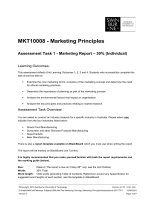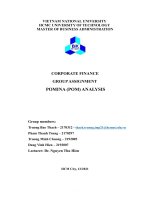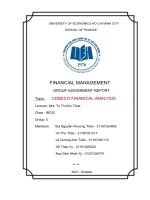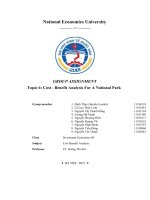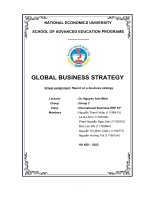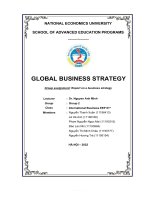Marketing principles group assignment nike strategy 4ps analysis report
Bạn đang xem bản rút gọn của tài liệu. Xem và tải ngay bản đầy đủ của tài liệu tại đây (2.02 MB, 37 trang )
Group-Assignment-Group 1-MKT101-MKT101 E
Marketing Principles (MKT101)
MARKETING PRINCIPLES
GROUP ASSIGNMENT
NIKE STRATEGY 4PS ANALYSIS REPORT
Lecturer: Bùi Thị Hạnh Thảo
Class: MKT101.E
Course: MKT101 – Marketing principles
Team Members:
4. Đoàn Thị Thu Hiền
1.Nguyễn Quang Huy
5. Trịnh Thế Hoàn
2.Nguyễn Anh Quân
6. Ngọc Văn Đức
3. Trần Thị Huyền Anh
1|Page
1
0
2|Page
1
0
INTRODUCTION
About this assignment
The 4Ps of marketing is a model for enhancing the components of your "marketing mix" –
the way in which you take a new product or service to market. It helps you to define your
marketing options in terms of price, product, promotion, and place so that your offering
meets a specific customer need or demand. The marketing mix is a good place to start
when you are thinking through your plans for a product or service, and it helps you to
avoid these kinds of mistakes (MindTools, n.d) [1]. In this group assignment, the 4Ps
marketing strategy of Nile will be analysed with all the details. Along with that is the
demographic survey, which will provide specific metrics to help find the pros or cons of
Nike's marketing strategy. And at the end of this research, recommendations will be
created for Nike to change or add to the company's marketing strategy to help Nike grow
better.
1.1
Description of service packages and development
Nike, Inc., formerly (1964–78) Blue Ribbon Sports, American sportswear company
headquartered in Beaverton, Oregon. It was founded in 1964 as Blue Ribbon Sports by
Bill Bowerman, a track-and-field coach at the University of Oregon, and his former
student Phil Knight. They opened their first retail outlet in 1966 and launched the Nike
brand shoe in 1972. The company was renamed Nike, Inc., in 1978 and went public two
years later. By the early 21st century, Nike had retail outlets and distributors in more than
170 countries, and its logo—a curved check mark called the “swoosh”—was recognized
throughout the world. (Britannica, 2021)[2]
From the late 1980s Nike steadily expanded its business and diversified its product line
through numerous acquisitions, including the shoe companies Cole Haan (1988; sold in
2012) and Converse, Inc. (2003), the sports-equipment producer Canstar Sports, Inc.
(1994; later called Bauer and sold in 2008), and the athletic apparel and equipment
company Umbro (2008; sold in 2012). In 1996 the company created Nike ACG (“allconditions gear”), which markets products for extreme sports such as snowboarding and
mountain biking. In the early 21st century Nike began selling sports-technology
accessories, including portable heart-rate monitors and high-altitude wrist compasses.
(Britannica, 2021)[2]
3|Page
1
0
1.2
Target customer and target market
Target customer:
For Nike, their mission is: BREAKING BARRIERS: "Nike exists to bring inspiration
and innovation to every athlete* in the world. Our Purpose is to move the world
forward through the power of sport – breaking barriers and building community to
change the game for all. *If you have a body, you are an athlete." It can be seen that the
target customer of this market is everyone. (About Nike-Nike,2021) [3]
Target market:
Nike’s target market is for people who regularly exercise and for those who wear
fashion trends as it goes well with modern-day clothing. Nike has classified their
customers mainly into three product groups, men’s product, women’s products and
kid’s product. For men’s products they have different types of shoes and clothes that
consist of lifestyle, running, gym, baseball & softball, tennis, golf or football. For
women’s products, unlike men’s products Nike provides various options for women as
Nike understands that women don’t really play American football therefore they
replace it with yoga. For kid’s products, Nike mainly targets young athletes like how
their mission statements bring inspiration to every athlete. Besides these, Nike provides
4|Page
1
0
their customers with a variety of colors for the shoes so that their targeted customers
can find the pair of shoes that suits them the best. Moreover, people in the society are
achieving healthy lifestyle, they start exercising more and eating healthy, people tend to
jog or do sports nowadays. Nike noticed the change and produced items that satisfied
the needs of their customers, for example, they produce more comfortable clothing and
footwear that are able to give customers an enjoyable exercise so that their customers
would prefer the items sold in Nike. (gradesfixer, 2019) [4]
ANALYZE THE RESULTS OF THE MARKET
RESEARCH
Nike is the world's largest supplier of athletic shoes and apparel and a major manufacturer of
sports equipment, with sales in excess of US$37.4 billion in fiscal year 2020 (ending 31 May,
2020). As of 2020, it is used by more than 75,400 people worldwide. In 2020, Nike's own
brand was valued at over $32 Billion, making it the most valuable of a number of manipulable
businesses. Earlier in 2017, Nike brand was valued at 29.6 billion USD. Nike ranked 89th on
the 2018 Fortune 500 list of the largest US corporations by total revenue. Let’s take a closer
look at its SWOT:
Nike’s Strengths
A. Strong Brand Awareness
Nike having a unique name in the world is a brand that is easily recognizable. It
is a popular brand and its name is easy to remember and pronounce as well.
When it comes to footwear, people think of this brand. The Nike logo is easily
understood, and everyone easily recognizes it without any second thought.
(managementglossary, 2020) [5]. The iconic swoosh and ubiquitous tagline
“Just do it” are powerful status symbols in many social and industry circles,
and the brand has come to represent the pinnacle of sportswear and footwear
for decades. Nike’s brand value across the globe was $34.8 billion.
(brandongaille, 2021) [6] Nike has captured about 31% of the global athletic
footwear market.(managementglossary, 2020)[5]
5|Page
1
0
B. Huge Customer Base
Nike has millions of customer from around the world who loyally follow
Nike’s trends, participate in Nike events, and even provide customer feedback.
Due to its huge customer base, Nike’s market cap has grown to $224 billion as
of Feb 2021. (bstrategyhub,2020) [7]
C. Base Product Line Touches Most Part of The Market
Nike isn’t just shoes. It maintains a vast line of athletic wear for all seasons and
many different sports. Nike stores and other retailers spotlight its ability to offer
something to every customer in the market for performance gear, and its lines
continue to expand based on consumer demand. Nike generated $30.6 billion in
revenue worldwide from its major product segments, including sportswear,
running gear, training gear, and specialty sport and footwear lines.
(brandongaille, 2021)[8]
D. Aimed For Sustainability
Nike’s CEO Mark Parker has addressed that they will continue to acknowledge
the environmental issues in the communities. The CEO ensures that Nike will
help to contribute in finding a solution against these environmental issues.
(bstrategyhub,2020)[9] Nike is ranked in the top three amongst the climate
friendly companies in the world in 2007. In 2019 nike has started making shoes
from the threads made up of the waste plastic from the ocean. Which is need of
the hour to eliminate plastics to go into the ocean. (marketingark, 2019)[10]
E. Low Manufacturing Cost
Most of Nike’s footwear is manufactured in foreign countries. In the fiscal year
2020, Vietnam produced 50%, China produced 22%, and Indonesia produced
24% of total Nike’s footwear. Other operations are in Argentina, Brazil, India,
Italy, and Mexico. (bstrategyhub, 2020)[11]
F. Multi – Channel Approach
Nike distributes its merchandise via retail stores using various physical and
online channels. Nike owns several retail stores around the world and also
distributes its products through independent licensees and distributors. This
multi-channel approach has allowed Nike to increase their customer base.
(advergize,2020)[12]. In the fiscal year 2019 and 2020, Nike spent $3.7 billion
and $3.5 billion respectively in their marketing (bstrategyhub,2020)[13]
6|Page
1
0
Nike’s Weakness
A. Lack of Diversification
Despite being one of the most well-known brands in the world, Nike is heavily
dependent on its footwear business to generate revenue. In today’s ever-sopredictable world, a business should not be heavily dependent on only one
segment. (advergize,2020) [14]
(Source: Saga, PHÂN TÍCH SWOT VÀ PESTLE CỦA NIKE)
B. Dependency on US Market
Even after having established itself globally, Nike still relies on the U.S Market
in terms of sales and revenue. In the fiscal year 2020, about 41% of Nike’s
sales came from the U.S, while the rest of 59% came globally. Despite its fame,
Nike depends on the U.S for substantial sales and growth. (bstrategyhub,2020)
[15]
C. Poor Labor Conditions in Foreign Countries
In the last 20 years, Nike has been consistently targeted regarding their poor
labor conditions. These issues include forced labor, child labor, low wages, and
horrific working conditions that were deemed “Unsafe” (bstrategyhub,2020)
[16]
7|Page
1
0
Nike’s Opportunities
Though Nike is considered one of the top brands, the retail market, especially
for sports apparel, is highly competitive. Several high-rated brands are
continually struggling their way to the top. Nike must look for opportunities
that can help them to expand their business. The company’s association with
non-profit organizations can allow them to create more products from recycled
goods if one of the top brands takes the initiative to involve its R&D team to
work on recycled products that will surely encourage other small brands. It will
support the environmental cause and also send the right message to the
customers. Nike should seize an opportunity by standing firm against any
accusations about upper management. The high number of controversies related
to the higher authority is harming their image. Nike should take steps against
labor treatment and sexual harassment, helping them develop a more dedicated
workforce. Since Nike has a successful online business, it can create more
AR/VR-related products. Nike has an association with many celebrated
athletes, so they have a better chance of growth if they bring in sports
sunglasses, accessories, or other fashion lines. Nike should try to look for more
expansion in the global market while controlling product quality.
(edrawmax,2020)[17] . Acording to " The Motley Fool ", the Jordan Brand
generated $3.6 billion of wholesale equivalent revenue in fiscal 2020. Air
Jordan sneakers remain a hot item in the footwear market, even after more than
20 years since Michael Jordan wore a Chicago Bulls uniform. Nike's wholesale
revenue from the Jordan Brand has risen sharply from $2.3 billion in fiscal
2015. Despite the recent store closures around COVID-19, the Jordan Brand
finished fiscal 2020 with revenue up 16% year over year by far Nike's fastestgrowing category.(The Motley Fool,2020)[18]
Nike’s Threats
There is an intense competition in the market by having the players like puma
and adidas. Nike has to maintain competitive pricing in the market and
maintain its position as a market leader.(marketingark,2019)[19]
8|Page
1
0
(Source: Saga, PHÂN TÍCH SWOT VÀ PESTLE CỦA NIKE)
Moreover, the negative impact of the epidemic on business performance should
be considered. According to the research which is carried by Ming Lv (Deputy
General Manager of Risk Management Dept. at China Development Bank
Hong Kong) [20] it mentions that due to the impact of the epidemic, in the
fourth quarter of 2020, about 90% of Nike's self-operated stores were closed for
about 8 weeks, which significantly affected the company's 2020. What is more,
due to the suspension of the company's wholesale partners, the wholesale
quantity decreased by nearly 50%, which reduced quarter4 revenue and
increased inventory. Although stores are gradually resumed operation since
mid-May, it is still a challenge for NIKE to quickly adjust itself to normal
business patterns and prepare to face the second outbreak of the COVID-19.
Primary Research
Demographic analysis, the statistical description of human populations, is a tool used by
government agencies, political parties, and manufacturers of consumer goods. Polls conducted
on every topic imaginable, from age to toothpaste preference, give the government and
corporations an idea of who the public is and what it needs and wants. The government's
census, which is conducted every ten years, is the largest demographic survey of all.
Today demographic is also being used as a noun; so, for example, TV advertisers are
constantly worrying about how to appeal to "the 18-to-24-year-old demographic". (Merriamwebster, 2020) [21]. Demographic segmentation isn’t just a one-time task. Different kinds of
segmentation may be useful for different brands and products, and you may find yourself
segmenting your audience in different ways at different times. (Qualtrics.com) [22].
9|Page
1
0
From the above information, you have a simple understanding of the concept of
demographics, demographic size. Survey about the brand Nike was participated by
165 people.
Overall, survey respondents are those aged between 16 and 20 with 64.2%,
while the figure for age over 30 accounts for only 17%. Moreover, those who
are still students, students account for 77%. This is a young group with no high
income, but they like Nike's designs.
10 | P a g e
1
0
Those who choose to buy Nike products because they feel like it accounted for
75.8%, while the number of people who bought because of the price increase of
the product in the future accounted for only 4.2%. The rest of the population
tend to choose to buy Nike products when they see a discount or promotion
with 29.7% or are influenced by fashion trends they see in people around with
30.9%.
The number of people who choose to buy Nike products is largely
because they like the company's designs and are not too concerned about
the price of the product that can be resold later.
Frequency of buying Nike products, 55.2% of people choose to buy Nike
products 1-5 times/year, while this number of people who buy products 5-10
times/year only accounts for 9.1 %. Not only that, customers who choose to
11 | P a g e
1
0
buy products more than once every 2 years accounted for 24.8%, on the other
hand, those who buy products 4-7 times a month only accounted for 1.2%.
Although the majority of 16-20 year olds choose to buy Nike products,
the frequency of purchases is quite low.
Most survey participants tend to buy Nike shoes and sandals with 85.5%, while
the number of sports equipment accounts for only 15.2%. In addition, 33% of
survey respondents choose to buy Nike fashion clothes while those who buy
sports clothes make up only 18.8%.
Nike footwear products are the first choice of customers when buying at
Nike. Moreover, Nike also affirms its position in fashion, not just a
brand specializing in selling sportswear.
12 | P a g e
1
0
According to data research, the number of people who routinely buy more
things that mix with the products they buy accounted for 63 percent, 16.4
percent of people who usually buy, and 20.6% of people who never buy."
As can be observed, the number of frequent purchasers is the largest, so
Nike should diversify items that can work together to raise the number of
regular buyers.
According to the pie chart, buyers spending less than 1,000,000 made up 36.4
percent, 1,000,000-2,000,000 made up 35.2 percent, 2,000,000-3,000,000 made
up 14.5 percent, and over 3,000,000 made up 13.9 percent.
As a result, Nike could offer a variety of discount schemes, provide
discounts to frequent shoppers, and implement a program that allows
customers to redeem points for presents in order to grow the number of
customers.
13 | P a g e
1
0
According to the survey, customers consider the price of Nike products to be
medium to high, with 1.2 percent believing the price is low, 7.9 percent
believing the average price is low, and 43 percent believing the price is not too
expensive. In terms of pricing, 40% believe it is fairly high, while 7.9% believe
it is high.
As a result, Nike should offer regular discounts and various types of
promotions in order to increase customer loyalty
Customers believe that the frequency with which they view Nike commercials
is mostly frequent, according to the survey, accounting for 49.7%. Meanwhile,
43 percent of people say they see it occasionally, while 7.3 percent say they
seldom see it.
14 | P a g e
1
0
Therefore, Nike needs to expand online advertising on electronic
channels and major social networking sites such as Facebook, Instagram,
and Twitter to reach more customers.
Customers report they see Nike commercials on social media on a regular basis
in 53.9 percent of cases, 26.1 percent on a regular basis in 26.1 percent of
cases, and 20% of cases do not see ads at all.
As a result, Nike still has to develop social networking site interaction
and promote advertising in a variety of other ways.
According to the survey, 78.8% of customers said they had never participated
in a Nike-related activity, while participants accounted for only 6.1% and
15.2% for occasional participants.
Therefore, Nike should promote the brand by organizing activities on a
large scale and in accessible places such as schools or annual fairs.
15 | P a g e
1
0
Most survey respondents expect Nike to apply a product discount promotion
with 67.9%, besides, 41.8% of customers want Nike to apply a buy one get one
free policy and 32.1 % of customers like to receive a gift on every order when
buying Nike products. The number of customers who like to be in a
sweepstakes and receive a voucher together accounted for 23%.
Therefore, Nike should understand the desire of customers to buy goods,
and at the same time make promotional policies in the most reasonable
way.
According to research, the majority of customers choose to buy Nike products
on the website or through communication channels such as Facebook,
connecting with sellers with 52.7%, while this number is only 46, 7% for
customers who come to buy directly at Nike stores. Moreover, only 24.8% of
customers decide to learn about the product and then decide to go to the stores
to buy.
16 | P a g e
1
0
Therefore, as the demand for online shopping of customers is increasing,
the number of customers coming to buy directly decreases. Nike should
focus on where there is a greater shopping need. Moreover, not many
customers decide to buy Nike products but have to find out first.
According to survey statistics, 54.5% of customers feel that Nike stores do not
provide enough products as shown on the website, while the number of
customers who feel Nike has enough products only accounts for 37.6%.
From here it can be seen that Nike's products are offered in a variety of
stores but are still not as complete as on the website. This can partly
explain the percentage of customers who choose to buy with online
images more than customers who buy offline.
According to the survey, 58.8% of customers are not too concerned about
whether Nike's store location is convenient for their needs to buy products at
the store. While the percentage of customers who feel that the location of
17 | P a g e
1
0
Nike's products is very convenient for their needs to buy products accounts for
35.2%.
Nike's location has ensured convenience for customers with only 6.1%
of customers disagreeing with this view. On the other hand, most
customers are not too interested in the location of Nike's stores.
According to a consumer satisfaction survey about Nike items, customers in
general highly value design, quality, .... specifically as follows:
When it comes to the variety of models, the most satisfied clients make up
24.24 percent of the total, which is a rather high rate of 32.12 percent. The
average number of reviewers is 36.36 percent and 5.45 percent, respectively,
indicating that customers believe the design is below average and that 1.83
percent of individuals are dissatisfied with the product's design.
18 | P a g e
1
0
In terms of product quality, 27.27 percent thought it was excellent, while 40.6
percent said it was good. Overall, 27.87 percent of people believed the quality
was excellent. Consumers rate quality as below average and poor to a degree of
3.03 percent and 1.23 percent, respectively. It demonstrates that customers
value Nike products highly and that just a small fraction of customers are
dissatisfied.
In terms of fashion design, 26.06 percent think the fashion of Nike products is
good, 39.39 percent think it's good, 30.9 percent say the design is average, 3.03
percent is a number of Percation on the plan to the level below the middle, and
1.23 percent think they don't fit Nike's design, so we can see that Nike's design
is completely suitable for the majority of customers row.
19 | P a g e
1
0
According to the survey, 26.06 percent of customers are extremely satisfied
with Nike product packaging, 42.81 percent believe that Nike packaging is very
nice, and the remaining customers believe that the packaging is atrocious. The
average rating is 27.27 percent, while between 1.83 percent and 3.03 percent of
customers believe the packing is bad. When the percentage of consumers is
21.21 percent, it's also worth mentioning Nike's return policy. Customers are
generally satisfied with Nike's return policy, with 36.36 percent believing the
company is good at returns, 35.15 percent rating the service as average, and
6.06 percent dissatisfied with the return policy. With 1.22 percent dissatisfied
with Nike's return policy, we can conclude that customers are generally
satisfied with Nike's return policy.
In terms of price, 11.51 percent of customers believe Nike charges a high price
in comparison to the market, while 31.51 percent believe the price is fairly
high, 42.21 percent believe the price is appropriate, and 13.3 percent believe
the price is rather high. The percentage of clients who believe the price is low is
1.47 percent, which is both inexpensive and affordable.
20 | P a g e
1
0
Furthermore, 10.3 percent are pleased because Nike offers numerous deals,
26.06 percent are pleased, 37.57 percent are pleased, and 22.42 percent are
dissatisfied, with 3.65 percent stating that they dislike it. As a result, we can see
that Nike will need to use a variety of promotional techniques to boost the
number of clients.
10.3 percent of consumers say Nike's discount is extremely high, while 21.21
percent think it is fairly high, and the average number of customers who think
the discount is very high is 41.81 percent, while 18.18 percent think it is very
low. 8.5 percent of customers expressed dissatisfaction with Nike discounts.
21 | P a g e
1
0
Furthermore, 29.69 percent of customers believe the brand image is extensively
distributed, 35.15 percent believe it is rather popular, 27.27 percent believe it is
only seen sometimes, and 6.06 percent believe it is uncommon. When asked if
they see the brand image, 1.83 percent responded no.
According to the survey, 16.36 percent of customers are satisfied with Nike's
community program, while 33.33 percent believe it is fairly excellent, 35.15
percent believe it is average, and 12.12 percent detest the program and 3.04
percent believe it is poor.
22 | P a g e
1
0
Customers stated the product is easy to locate and purchase 22.42 percent of the
time, 38.78 percent said they have no problems locating the product, and 29.69
percent said they have no trouble finding the product and making purchases.
Up to 6.06 percent of buyers claimed they had trouble locating and purchasing
things, while 3.05 percent said they had a lot of trouble finding products and
finding them difficult to buy.
Customers believe showrooms are relatively easy to find, with 22.42 percent
believing they are very easy to find showrooms, 29.09 percent believing there
is no difficulty in finding showrooms, and 35.15 percent believing it is normal,
but 2.44 percent to 10.9 percent believing they have a great deal of difficulty in
finding showrooms, according to the report.
23 | P a g e
1
0
Employee enthusiasm is also a factor in the brand's success; 18.18 percent of
customers think Nike's enthusiasm is very high, 40.6 percent think it is quite
high, and 35.75 percent believe employees need more enthusiasm; 4.24 percent
think the staff's attitude is not very good, and 1.13 percent think the staff has a
rather bad attitude.
Furthermore, Nike is highly ranked in terms of freight: 17.57 percent of
customers believe Nike delivers very swiftly, 35.15 percent say they love
Nike's freight, and 37.57 percent say Nike delivered on time with no
complaints. However, up to 7.87 percent of customers believe Nike's shipment
is delayed, and 1.84 percent are dissatisfied with it.
As a result, Nike must improve a number of other aspects in order to
please customers.
24 | P a g e
1
0
4PS MARKETING STRATEGY
Marketing Mix of Nike analyses the brand/company which covers 4Ps (Product, Price, Place,
Promotion) and explains the Nike marketing strategy. Marketing strategy helps companies
achieve business goals & objectives, and marketing mix (4Ps) is the widely used framework to
define the strategies. Let's see the Marketing strategy of Nike.
Nike Product Strategy
Nike has a wide range of products to offers to its target customers. The
Marketing Mix of Nike consists of products which fall under below three
categories include footwear, apparel, equipment and accessories.
(mbaskool.com)[23]
Nike offers great variety of products including special type of shoes for every
category of sports. For example, it has special quality of shoes for football,
basketball, cricket and other sports. Nike has different products for different
customer segments and over the years have added to the width and depth of its
products basis the changing needs of its customers. (mbaskool.com). Sales data
from 2009 – 2020 highlight that most North American sales are attributed to
athletic footwear. Investment in research and development allows Nike to
leverage existing technological advancements to provide consumers with
innovative product design and functionality. The current brand portfolio
includes the Nike brand, Jordan, Hurley, and Converse. Nike's global branding
is one reason why the company continues to dominate the global footwear
market. (globalmarketingprofessor,2021) [24]
(Source : Statista - Nike's North American revenue from 2009 to 2020, by segment )
25 | P a g e
1
0


